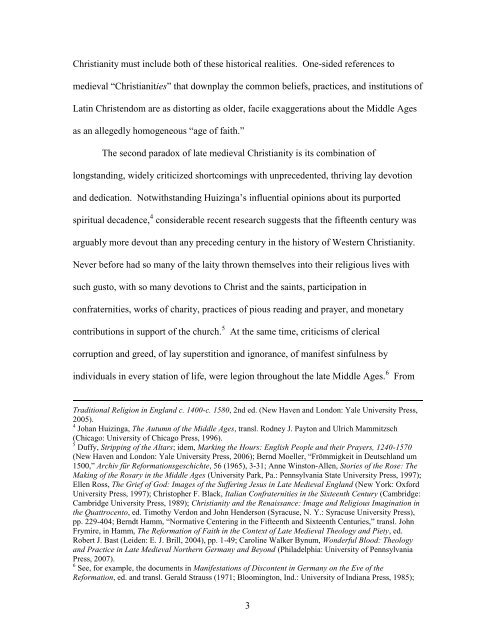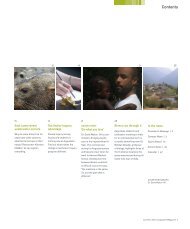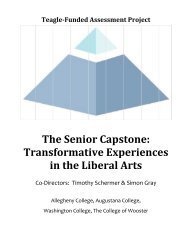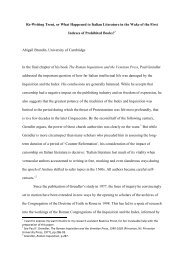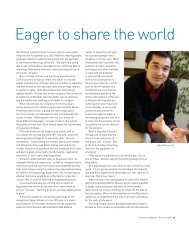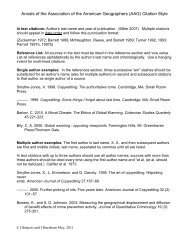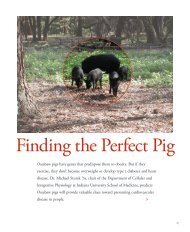Brad S. Gregory - Augustana College
Brad S. Gregory - Augustana College
Brad S. Gregory - Augustana College
Create successful ePaper yourself
Turn your PDF publications into a flip-book with our unique Google optimized e-Paper software.
Christianity must include both of these historical realities. One-sided references to<br />
medieval “Christianities” that downplay the common beliefs, practices, and institutions of<br />
Latin Christendom are as distorting as older, facile exaggerations about the Middle Ages<br />
as an allegedly homogeneous “age of faith.”<br />
The second paradox of late medieval Christianity is its combination of<br />
longstanding, widely criticized shortcomings with unprecedented, thriving lay devotion<br />
and dedication. Notwithstanding Huizinga‟s influential opinions about its purported<br />
spiritual decadence, 4 considerable recent research suggests that the fifteenth century was<br />
arguably more devout than any preceding century in the history of Western Christianity.<br />
Never before had so many of the laity thrown themselves into their religious lives with<br />
such gusto, with so many devotions to Christ and the saints, participation in<br />
confraternities, works of charity, practices of pious reading and prayer, and monetary<br />
contributions in support of the church. 5 At the same time, criticisms of clerical<br />
corruption and greed, of lay superstition and ignorance, of manifest sinfulness by<br />
individuals in every station of life, were legion throughout the late Middle Ages. 6 From<br />
Traditional Religion in England c. 1400-c. 1580, 2nd ed. (New Haven and London: Yale University Press,<br />
2005).<br />
4<br />
Johan Huizinga, The Autumn of the Middle Ages, transl. Rodney J. Payton and Ulrich Mammitzsch<br />
(Chicago: University of Chicago Press, 1996).<br />
5<br />
Duffy, Stripping of the Altars; idem, Marking the Hours: English People and their Prayers, 1240-1570<br />
(New Haven and London: Yale University Press, 2006); Bernd Moeller, “Frömmigkeit in Deutschland um<br />
1500,” Archiv für Reformationsgeschichte, 56 (1965), 3-31; Anne Winston-Allen, Stories of the Rose: The<br />
Making of the Rosary in the Middle Ages (University Park, Pa.: Pennsylvania State University Press, 1997);<br />
Ellen Ross, The Grief of God: Images of the Suffering Jesus in Late Medieval England (New York: Oxford<br />
University Press, 1997); Christopher F. Black, Italian Confraternities in the Sixteenth Century (Cambridge:<br />
Cambridge University Press, 1989); Christianity and the Renaissance: Image and Religious Imagination in<br />
the Quattrocento, ed. Timothy Verdon and John Henderson (Syracuse, N. Y.: Syracuse University Press),<br />
pp. 229-404; Berndt Hamm, “Normative Centering in the Fifteenth and Sixteenth Centuries,” transl. John<br />
Frymire, in Hamm, The Reformation of Faith in the Context of Late Medieval Theology and Piety, ed.<br />
Robert J. Bast (Leiden: E. J. Brill, 2004), pp. 1-49; Caroline Walker Bynum, Wonderful Blood: Theology<br />
and Practice in Late Medieval Northern Germany and Beyond (Philadelphia: University of Pennsylvania<br />
Press, 2007).<br />
6<br />
See, for example, the documents in Manifestations of Discontent in Germany on the Eve of the<br />
Reformation, ed. and transl. Gerald Strauss (1971; Bloomington, Ind.: University of Indiana Press, 1985);<br />
3


